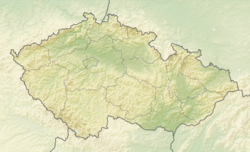Frýdlant nad Ostravicí (Czech pronunciation: [ˈfriːdlant ˈnat ostravɪtsiː]; German: Friedland (an der Ostrawitza)) is a town in Frýdek-Místek District in the Moravian-Silesian Region of the Czech Republic. It has about 9,900 inhabitants.
Frýdlant nad Ostravicí | |
|---|---|
 The town as seen from the slope of Lysá hora | |
| Coordinates: 49°35′34″N 18°21′35″E / 49.59278°N 18.35972°E | |
| Country | |
| Region | Moravian-Silesian |
| District | Frýdek-Místek |
| First mentioned | 1395 |
| Government | |
| • Mayor | Helena Pešatová |
| Area | |
| • Total | 21.91 km2 (8.46 sq mi) |
| Elevation | 357 m (1,171 ft) |
| Population (2024-01-01)[1] | |
| • Total | 9,923 |
| • Density | 450/km2 (1,200/sq mi) |
| Time zone | UTC+1 (CET) |
| • Summer (DST) | UTC+2 (CEST) |
| Postal code | 739 11 |
| Website | www |
Administrative parts
editFrýdlant nad Ostravicí is made up of three town parts and villages: Frýdlant, Lubno and Nová Ves.
Geography
editFrýdlant nad Ostravicí is located about 8 kilometres (5 mi) south of Frýdek-Místek and 23 km (14 mi) south of Ostrava. It lies mostly in the Moravian-Silesian Foothills; the southern part of the municipal territory extends into the Moravian-Silesian Beskids. The highest point is at 730 m (2,400 ft) above sea level.
The town lies on the Ostravice River, at its confluence with the Čeladenka Stream. The left bank of the Ostravice with the town proper lies in the historical land of Moravia, while the right bank with the villages of Lubno and Nová Ves lies in Czech Silesia.
History
editThe first written mention of Frýdlant is from 1395. The town was founded in the second half of the 14th century during German Ostsiedlung. It was established as a market town that was supposed to be the local centre of trade and handicrafts. In 1402, Frýdlant was sold by lords of Kravaře to Duke Przemyslaus I Noszak and joined to Duchy of Teschen. Frýdlant found itself on the periphery, lost its position and became a mere village. The economy was also hit by the Hussite Wars.[2]
In the 16th century, Frýdlant was sold to the Olomouc Bishopric and became part of the Hukvaldy estate. It was the impetus for the re-development of crafts. In 1625, the village received various privileges from the bishop Franz von Dietrichstein. During the Thirty Years' War, Frýdlant suffered from frequent army crossings.[2]
Between 1646 and 1648, the first hammer mills were built and Frýdland gradually became a centre of ironworks. The village later known as Nová Ves was founded near the hammer mills in 1647. In 1675, blast furnaces were built. Thanks to the development of the ironworks and the prosperous paper mill, the village was promoted by Maria Theresa to the market town again in 1775.[2]
The railway was built in 1871. Large fires in 1886 and 1890 damaged the market town severely. In 1948, Frýdland was promoted to a town.[2]
Demographics
edit
|
|
| ||||||||||||||||||||||||||||||||||||||||||||||||||||||
| Source: Censuses[3][4] | ||||||||||||||||||||||||||||||||||||||||||||||||||||||||
Transport
editFrýdlant nad Ostravicí is located on the railway lines Ostrava–Frýdlant nad Ostravicí and Frýdek-Místek–Ostravice.[5]
Education
editTwo gymnasiums are located in Frýdlant nad Ostravicí, the public Frýdlant nad Ostravicí Gymnasium and the private Beskydy Mountain Academy.[6]
Sights
editThe landmark of the town is the Church of Saint Bartholomew, built in 1672–1690. Other monuments at the town square are the neo-Renaissance town hall from 1894 and a Baroque Marian column with a rare statue of the Virgin Mary of Carmel from 1731.[7]
The monastery of the Sisters of Mercy of St. Charles Borromeo with a neo-Romanesque chapel dates from the second half of the 19th century. Today it is used as a retirement home. There are also several original wooden houses that are reminiscent of the original appearance of the town.[7]
Notable people
edit- Dominik Trčka (1886–1959), Catholic priest and martyr
- Ferdiš Duša (1888–1958), artist
- Petr Faldyna (born 1976), footballer
Twin towns – sister cities
editReferences
edit- ^ "Population of Municipalities – 1 January 2024". Czech Statistical Office. 2024-05-17.
- ^ a b c d "Historie a současnost" (in Czech). Město Frýdlant nad Ostravicí. Retrieved 2022-03-01.
- ^ "Historický lexikon obcí České republiky 1869–2011" (in Czech). Czech Statistical Office. 2015-12-21.
- ^ "Population Census 2021: Population by sex". Public Database. Czech Statistical Office. 2021-03-27.
- ^ "Detail stanice Frýdlant n.Ostravicí" (in Czech). České dráhy. Retrieved 2024-05-20.
- ^ "Strategický plán rozvoje města Frýdlant nad Ostravicí na období 2016–2025" (in Czech). Město Frýdlant nad Ostravicí. pp. 48–49. Retrieved 2022-03-01.
- ^ a b "Frýdlant nad Ostravicí" (in Czech). CzechTourism. Retrieved 2022-03-01.
- ^ "Partnerská města" (in Czech). Město Frýdlant nad Ostravicí. Retrieved 2022-03-01.


